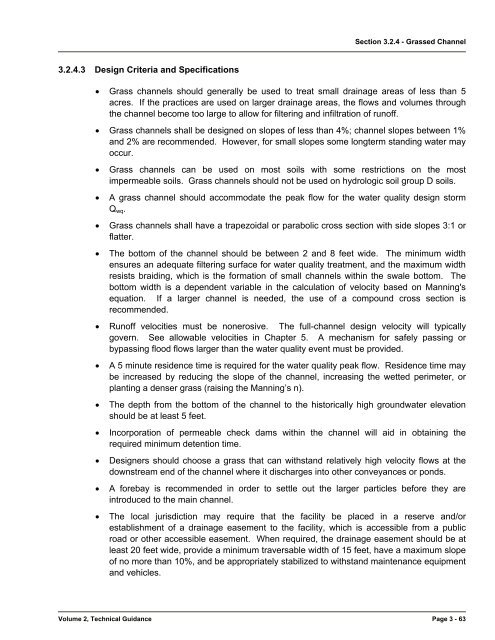Volume 2-05, Chapter 3 - City of Wichita
Volume 2-05, Chapter 3 - City of Wichita
Volume 2-05, Chapter 3 - City of Wichita
Create successful ePaper yourself
Turn your PDF publications into a flip-book with our unique Google optimized e-Paper software.
Section 3.2.4 - Grassed Channel<br />
3.2.4.3 Design Criteria and Specifications<br />
• Grass channels should generally be used to treat small drainage areas <strong>of</strong> less than 5<br />
acres. If the practices are used on larger drainage areas, the flows and volumes through<br />
the channel become too large to allow for filtering and infiltration <strong>of</strong> run<strong>of</strong>f.<br />
• Grass channels shall be designed on slopes <strong>of</strong> less than 4%; channel slopes between 1%<br />
and 2% are recommended. However, for small slopes some longterm standing water may<br />
occur.<br />
• Grass channels can be used on most soils with some restrictions on the most<br />
impermeable soils. Grass channels should not be used on hydrologic soil group D soils.<br />
• A grass channel should accommodate the peak flow for the water quality design storm<br />
Q wq .<br />
• Grass channels shall have a trapezoidal or parabolic cross section with side slopes 3:1 or<br />
flatter.<br />
• The bottom <strong>of</strong> the channel should be between 2 and 8 feet wide. The minimum width<br />
ensures an adequate filtering surface for water quality treatment, and the maximum width<br />
resists braiding, which is the formation <strong>of</strong> small channels within the swale bottom. The<br />
bottom width is a dependent variable in the calculation <strong>of</strong> velocity based on Manning's<br />
equation. If a larger channel is needed, the use <strong>of</strong> a compound cross section is<br />
recommended.<br />
• Run<strong>of</strong>f velocities must be nonerosive. The full-channel design velocity will typically<br />
govern. See allowable velocities in <strong>Chapter</strong> 5. A mechanism for safely passing or<br />
bypassing flood flows larger than the water quality event must be provided.<br />
• A 5 minute residence time is required for the water quality peak flow. Residence time may<br />
be increased by reducing the slope <strong>of</strong> the channel, increasing the wetted perimeter, or<br />
planting a denser grass (raising the Manning’s n).<br />
• The depth from the bottom <strong>of</strong> the channel to the historically high groundwater elevation<br />
should be at least 5 feet.<br />
• Incorporation <strong>of</strong> permeable check dams within the channel will aid in obtaining the<br />
required minimum detention time.<br />
• Designers should choose a grass that can withstand relatively high velocity flows at the<br />
downstream end <strong>of</strong> the channel where it discharges into other conveyances or ponds.<br />
• A forebay is recommended in order to settle out the larger particles before they are<br />
introduced to the main channel.<br />
• The local jurisdiction may require that the facility be placed in a reserve and/or<br />
establishment <strong>of</strong> a drainage easement to the facility, which is accessible from a public<br />
road or other accessible easement. When required, the drainage easement should be at<br />
least 20 feet wide, provide a minimum traversable width <strong>of</strong> 15 feet, have a maximum slope<br />
<strong>of</strong> no more than 10%, and be appropriately stabilized to withstand maintenance equipment<br />
and vehicles.<br />
<strong>Volume</strong> 2, Technical Guidance Page 3 - 63
















